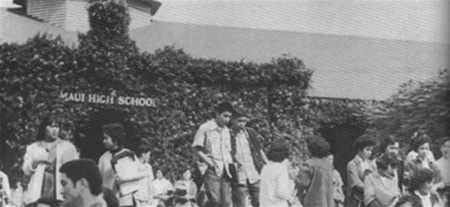Old School Spirit
More
than three decades after being abandoned to the elements, vandals and
arson, Maui’s first public high school is kindling a passion for
renewal.

Jill Engledow
Photographs courtesy of Friends of Old Maui High School | Ron Dahlquist
When
Maui High School was founded in 1913, the island was a rural community
of some 32,000, mostly immigrants working in cane fields and sugar
mills. Education was available only though grammar school,
though boys could continue into their teen years at Lahainaluna, then a
vocational-trade school. The upper classes hired tutors, or sent their
children to Punahou on O‘ahu or to the Mainland for secondary
education. But a growing Caucasian middle class wanted their children
educated at home.
In the 1920s and 1930s, students arrived at school courtesy of the Kahului Railroad.
So
Maui High was begun, the island’s first coeducational public high
school and the third in Hawai‘i. Sited at an incredibly beautiful
location two miles above Ho‘okipa Beach, the school overlooked the
ocean and a coastline stretching to the cloud-crowned mountains of West
Maui. Haleakala provided a backdrop for a verdant campus surrounded by
fields of sugarcane, cooled by trade winds and kept green by windward
showers. Generations of students would enjoy this quiet, spacious
campus.
The school was located near the
plantation camp of Hamakuapoko, then a thriving village not far from
the population centers of Pa‘ia and Pu‘unene. At the end of the first
year, the school had sixteen freshmen and sophomores, most from Maui’s
prosperous Caucasian families.
That was
soon to change, as immigrant families seeking a better future for their
children took advantage of this opportunity for a free education. Some
middle managers in the plantation community opposed the education of
these “alien” children (most of whom were, in fact, American citizens
by birth). If you gave such children an education, they would grow up
wanting more than a job in the fields. And in a time when race and
ethnicity were seen as legitimate dividing lines in society, some white
parents preferred that their children not be exposed to other cultures
and to those who communicated in pidgin English.
| Be the first to rate this | |